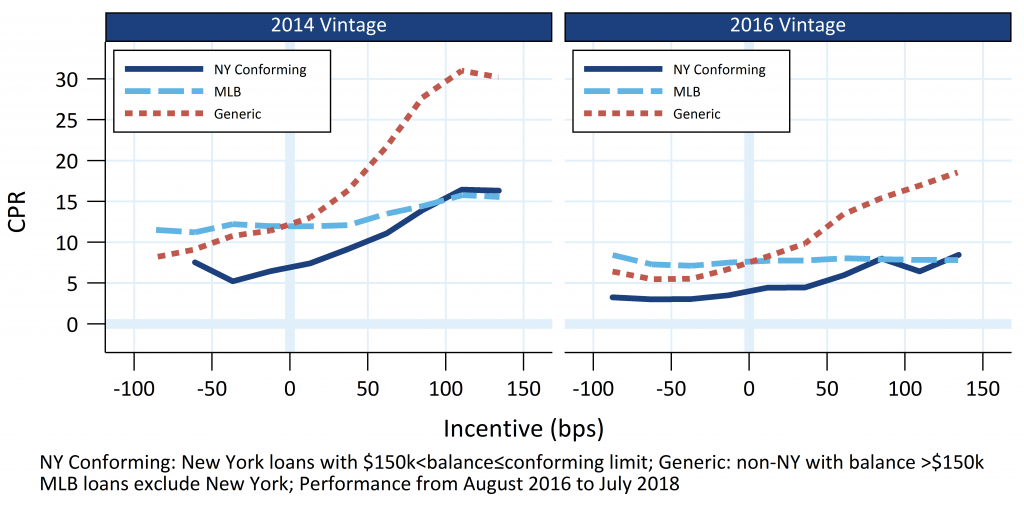Uncategorized
A few more reasons to like New York
admin | September 7, 2018
This document is intended for institutional investors and is not subject to all of the independence and disclosure standards applicable to debt research reports prepared for retail investors. This material does not constitute research.
Pass-throughs near par backed by loans from New York offer some of the better current value among agency MBS specified pools. These pools price from 5% to 50% of theoretical value since they offer clear call protection in a market arguably more focused on extension. Local mortgage recording taxes help create the convexity. Add that to the list of things to like about New York.
New York pools have slow, flat S-Curves
New York loans have historically exhibited very slow prepayment speeds and continue to be a good source of call protection. New York state charges a large tax on new mortgages that borrowers must pay at closing, which means that a New York borrower will have less incentive to refinance than a borrower in a similar loan from another state. This collateral looks especially attractive at near-par coupons (3.5%s and 4.0%s)—the market prices these loans well below theoretical value since these pools underperform in higher interest rate scenarios. These pools could be a source of inexpensive call protection for investors with a strong view that rates will go lower.
Exhibit 1 (below) compares prepayment speeds for New York loans with balances greater than $150,000 and less than the conforming limit to non-New York loans with the same range of balances. It also includes a comparison to MLB collateral—pools with a maximum loan size of $110,000.
Exhibit 1: NY, Generic and MLB S-Curves, last 24 months

Source: Fannie Mae, Freddie Mac, eMBS, 1010data, Amherst Pierpont Securities
The market has understood for a long time that New York loans prepay slowly; the past two years’ performance was chosen to demonstrate that this hasn’t recently changed. A concern was that the 2018 cap on the federal tax deduction of state and local taxes (“SALT”) would fuel an exodus out of New York. However, this isn’t visible in the data, and most people find it difficult to make major life changes to avoid a tax increase. The 2014 and 2016 vintages were chosen to show that the speed difference exists for newer and more seasoned loans.
New York loans prepay comparably to MLB loans from other states at the fastest part of the S-curve, but at lower rate incentives New York loans prepay much slower than the MLB loans. Therefore New York loans provide substantial call protection, but underperform in a discount environment since they extend more than generic and loan balance collateral.
New York’s mortgage recording tax slows prepayment speeds
Prepayment speeds are slow in New York due to the state’s “mortgage recording tax” for new mortgages. This tax is very high and varies, by locality, from 75 bp to 212.5 bp. Using a 5× IO multiple implies that a New York borrower is 15–42.5 bp further out-of-the-money than a borrower with the same note rate in most other states. Furthermore, the mortgage process in New York is more costly and has higher frictions due to other factors. For example, most New York loans require lawyer(s) to be involved with the closing process, but this is not necessary in most other states.
The empirical data shows that New York loans are slow to refinance despite a mechanism to avoid paying the recording tax on a refinance. This is known as a “CEMA” (Consolidation, Extension, or Modification Agreement)—it modifies the terms of the original mortgage instead of recording a new mortgage. However, borrowers have to pay additional fees to execute the CEMA, which offsets some of the tax savings. Also, the existing lender has to agree to do the CEMA, which means they can refuse to if the borrower is using a different lender for the new loan. This gives the lender leverage to charge an above-market rate to those borrowers.
The recording tax cannot be avoided on a purchase transaction, except in the case of a co-op property.
New York pay-ups look low on lower coupons
Exhibit 2 (below) shows YieldBook’s theoretical pay-ups on three 2018 vintage 100% New York pools.
Exhibit 2: Payups are cheap to theoretical value (as of 9/6/2018)

Source: YieldBook, Amherst Pierpont Securities
Lower coupon New York pools could be an inexpensive source of call protection for investors with a strong view that rates will move lower. The model thinks market pay-ups are very low on 3.5%s and relatively low on 4.0%s—5.1% and 47.1% of theoretical value, respectively. The market does not offer much pay-up at lower coupons since these loans don’t perform well in higher interest rate environments, but it appears that market pricing is too punitive. 4.5%s, however, appear to be fully priced at 102.7% of theoretical value.
It almost goes without saying that investors can magnify the value of New York pools through IO, inverse IO and other mortgage structures.


